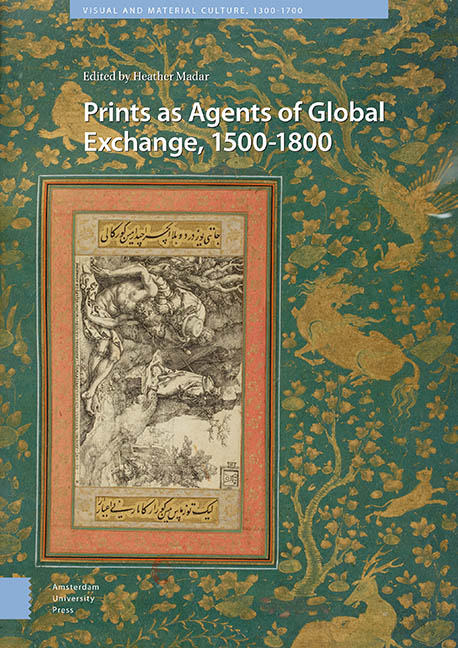Book contents
- Frontmatter
- Table of Contents
- List of illustrations
- Introduction
- 1 Concealing and Revealing the Female Body in European Prints and Mughal Paintings
- 2 The Sultan’s Face Looks East and West: European Prints and Ottoman Sultan Portraiture
- 3 From Europe to Persia and Back Again: Border-Crossing Prints and the Asymmetries of Early Modern Cultural Encounter
- 4 The Dissemination of Western European Prints Eastward: The Armenian Case
- 5 The Catholic Reformation and Japanese Hidden Christians: Books as Historical Ties
- 6 (Re)framing the Virgin of Guadalupe: The Concurrence of Early Modern Prints and Colonial Devotions in Creating the Virgin
- 7 Hidden Resemblances: Re-contextualized and Re-framed: Diego de Valadés’ Cross Cultural Exchange
- 8 The Practice of Art: Auxiliary Plastic Models and Prints in Italy, Spain, and Peru
- 9 Ink and Feathers: Prints, Printed Books, and Mexican Featherwork
- Index
9 - Ink and Feathers: Prints, Printed Books, and Mexican Featherwork
Published online by Cambridge University Press: 16 December 2021
- Frontmatter
- Table of Contents
- List of illustrations
- Introduction
- 1 Concealing and Revealing the Female Body in European Prints and Mughal Paintings
- 2 The Sultan’s Face Looks East and West: European Prints and Ottoman Sultan Portraiture
- 3 From Europe to Persia and Back Again: Border-Crossing Prints and the Asymmetries of Early Modern Cultural Encounter
- 4 The Dissemination of Western European Prints Eastward: The Armenian Case
- 5 The Catholic Reformation and Japanese Hidden Christians: Books as Historical Ties
- 6 (Re)framing the Virgin of Guadalupe: The Concurrence of Early Modern Prints and Colonial Devotions in Creating the Virgin
- 7 Hidden Resemblances: Re-contextualized and Re-framed: Diego de Valadés’ Cross Cultural Exchange
- 8 The Practice of Art: Auxiliary Plastic Models and Prints in Italy, Spain, and Peru
- 9 Ink and Feathers: Prints, Printed Books, and Mexican Featherwork
- Index
Summary
Abstract
This article discusses the role prints played in the crafting of Mexican featherwork. Feather mosaics were a mixed cultural artifact in which Christian images derived from prints interacted with a typical native technique. The resulting images were not mere copies, as the artists were adapting and modifying their visual source(s), choosing specific imagery and, sometimes, combining different prints. Moreover, the final image took on an entirely different vitality, thanks to the feathers’ natural shimmering. Particular attention will be given to how the mosaics’ design was discussed in textual sources from the sixteenth and seventeenth centuries, and how and when prints surfaced in their discourse.
Keywords: featherwork, globalization of images, colonial Mexico, artistic literature
One of the main Pre-Columbian crafts that successfully survived the colonization, adapting itself to visualize Christian and European themes, Mexican featherwork has recently been the recipient of substantial scholarly interest, especially thanks to Alessandra Russo's studies. Preceded by objects decorated with feathers that were noted since Columbus’ arrival, and Brazilian Tupinamba's capes, the Mexican variation started to arrive in Europe as early as 1519-1520 through a variety of works of art, ranging from headdresses to shields. Feather mosaics (or paintings, as they were also called) with Christian imagery, a combination of material and iconography that was novel for both sides, as rightly stressed by Russo, quickly appeared in the years following the Conquest. One of the earliest recorded examples, a standard depicting a Virgin and Child, dates from 1529-31. The first surviving mosaic, the Gregorymass of Auch, was created under the direction of Franciscan friar Pedro de Gante/Pieter van der Moere in Mexico City in 1539, when Diego de Alvarado Huanitzin was governor, to be presented to Pope Paul III. Surviving objects and mentions of Christian featherwork multiply from the 1540s. By 1548 feathered vestments for the clergy existed, as in this year two miters were recorded in the inventory of Mencía de Mendoza. Even portraits were made.
The fact that colonial mosaics were frequently based on prints is well known, and a list of derivations could be quite long. To name a few cases, the Gregorymass of Auch has been linked to an engraving by Israhel van Meckenem – although I agree with Alessandra Russo that this comparison is not completely satisfactory.
- Type
- Chapter
- Information
- Prints as Agents of Global Exchange, 1500-18001500-1800, pp. 283 - 316Publisher: Amsterdam University PressPrint publication year: 2021

